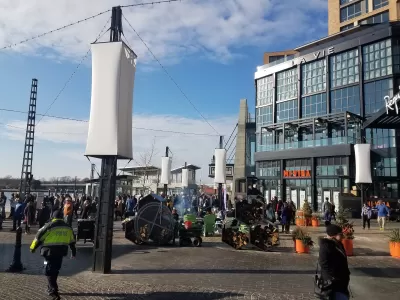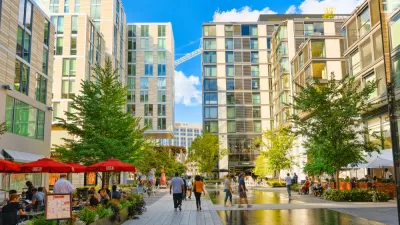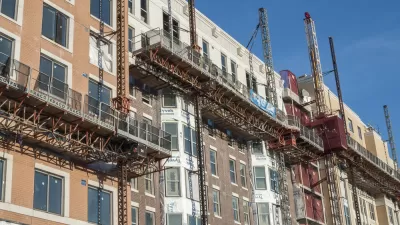Did The Wharf, a new mixed use mega project in Washington, D.C., deliver enough public benefit to warrant its large public subsidy?

After the Great Recession, millennials flocked to large cities such as New York, Washington, D.C., and San Francisco for stronger job prospects. We are seeing the opposite trend now, as millennials leave large cities with high living costs. Average rents for apartments in New York City are running more than $3,000 a month, and new luxury developments are popping up on seemingly every other corner in popular Manhattan neighborhoods.
The transformation of New York into a playground for the rich has been well-documented, most recently in Alessandro Busà's book, The Creative Destruction of New York City: Engineering the City for the Elite. But the phenomenon extends to other cities, like Washington, D.C., as zoning laws that restrict land-use have created a shortage of affordable housing. A recent example of D.C.'s attempts to eliminate opportunity for anyone without a trust fund is the newly-opened development at The Wharf.
Located in the southwest quadrant of D.C. on the Washington Channel, The Wharf's completed phase one features a series of modern, luxury highrises, a hotel, and various retail and dining options on the ground floors of each. One building features a banner that reads "Live Life Amplified"––no clarification of the amplified life's price tag included. But it includes upscale bike stores, public marshmallow roasts, rooftop cocktail lounges, Shake Shack, ice skating rinks, and dodging troves of people on uncomfortable and thin cobblestone walkways, all as Christmas music is blasted in surround sound.
 The Wharf's mixed-use, highrise development, as viewed from Maine Avenue, SW. (Image: Jerrod A. Laber)
The Wharf's mixed-use, highrise development, as viewed from Maine Avenue, SW. (Image: Jerrod A. Laber)
The average rent in Washington, D.C. is $1,899 a month. The Wharf currently features two separate apartment complexes, with 649 apartments total. The Southwester reports that 131 of those apartments are "affordable apartments for households earning 60% and 30% Area Median Income or less." That might seem admirable, but the deal developers received from the city government makes it less so.
The land that The Wharf sits on was previously public property. Appraisers valued the property worth $95 million. An investigation by WAMU 88.5 found that the city sold the land for $1. The municipal government also distributed an almost $200 million subsidy to developers. The WAMU investigation found further that development teams in D.C. that get the most lucrative land deals are also the largest donors to city officials from their industry over a ten-year period. Ben Soto, the head of one firm involved in The Wharf, is Mayor Muriel Bowser's campaign treasurer. He was also head of a political action committee that shut down for raising uncapped contributions from individuals who had access to Bowser. Developers deny receiving special treatment.
The pre-designated affordable units were part of the deal with the city. But the affordable apartments are typically called "micro-units" that are roughly 330 square feet in size, according to journalist Shantella Sherman in the Afro-American. Given that the city's poor residents spend more than 80 percent [pdf] of their income on rent, a few rent-controlled apartments in a luxury development is purely cosmetic. One neighborhood resident described it as paying "$2,000 for a tea cup." The same resident complained of the local displacement, as the development caused "the replacement of at least fifteen retail shops – ones that everyone used; the butcher, clothing stores, hair salon, cleaners, and affordable eateries."
 District Pier at The Wharf. (Image: Jerrod A. Laber)
District Pier at The Wharf. (Image: Jerrod A. Laber)
Housing is not just a problem in D.C., but also in the suburbs. Rents in Arlington, Virginia run just shy of $2,000 a month. A study released in 2013 found a 47 percent increase in average rents, with only a 37 percent increase in average salary over the previous three years. Much like across the river in the District, Arlington's low-income citizens are increasingly left with fewer options. In one instance, over 3,000 people applied to an affordable housing complex that had only 122 available apartments.
Lack of affordable housing has implications for D.C.'s more than double the national average homeless population. Sociologist Matthew Desmond's book, Evicted: Poverty and Profit in the American City, shows how the cycle of poverty for Milwaukee's low-income residents is driven by housing instability. The situation is the same in D.C., as high housing costs means a "higher risk of being evicted, moving frequently, living in crowded or substandard conditions, or becoming homeless," according [pdf] to the DC Fiscal Policy Institute. Eviction can mean losing a job, and having to move to a neighborhood with more crime and worse schools.
Cities do have a lot to offer. As urban economist Edward Glaeser notes in his book Triumph of the City, "urban density provides the clearest path from poverty to prosperity." But in D.C., broad swaths of land are zoned to prevent high-density housing from being built. More supply would bring prices down. Instead, projects like The Wharf contribute further to inequality and displacement. There's inherently a racial element to this inequity, as the neighborhoods affected are largely minority ones.
In the '70s, 90 percent of the U Street Corridor residents were African-American. The introduction of the Metro––which forced many businesses to close during construction––and other city hall-led initiatives attracted wealthier residents. Real estate developers milked the demand for all its worth. Now, African-Americans make up roughly 30 percent of the neighborhood.
The American ethos argues that individuals are in charge of their destiny, regardless of the circumstances of their birth. The rising tide of prosperity lifts all boats, but some people were pushed out of the boat with only a barely-functioning life vest. As the work of economist Raj Chetty and others show, where you are born predicts a lot about your prospects in life.
If you are born in a luxury condominium on The Wharf, you're probably going to be fine. But if you are born two Metro stops away in the largely African-American neighborhoods, where the poverty rate is three times the city average, it's going to be an uphill battle. Cronyist land grabs and bad public policy only exacerbate this problem.
Jerrod A. Laber is a writer and Free Society Fellow with Young Voices Advocates. He lives in Northern Virginia, but was born, raised, and educated in Appalachia.

Study: Maui’s Plan to Convert Vacation Rentals to Long-Term Housing Could Cause Nearly $1 Billion Economic Loss
The plan would reduce visitor accommodation by 25,% resulting in 1,900 jobs lost.

North Texas Transit Leaders Tout Benefits of TOD for Growing Region
At a summit focused on transit-oriented development, policymakers discussed how North Texas’ expanded light rail system can serve as a tool for economic growth.

Why Should We Subsidize Public Transportation?
Many public transit agencies face financial stress due to rising costs, declining fare revenue, and declining subsidies. Transit advocates must provide a strong business case for increasing public transit funding.

How Community Science Connects People, Parks, and Biodiversity
Community science engages people of all backgrounds in documenting local biodiversity, strengthening connections to nature, and contributing to global efforts like the City Nature Challenge to build a more inclusive and resilient future.

Alabama: Trump Terminates Settlements for Black Communities Harmed By Raw Sewage
Trump deemed the landmark civil rights agreement “illegal DEI and environmental justice policy.”

Dear Tesla Driver: “It’s not You, It’s Him.”
Amidst a booming bumper sticker industry, one writer offers solace to those asking, “Does this car make me look fascist?”
Urban Design for Planners 1: Software Tools
This six-course series explores essential urban design concepts using open source software and equips planners with the tools they need to participate fully in the urban design process.
Planning for Universal Design
Learn the tools for implementing Universal Design in planning regulations.
City of Santa Clarita
Ascent Environmental
Institute for Housing and Urban Development Studies (IHS)
City of Grandview
Harvard GSD Executive Education
Toledo-Lucas County Plan Commissions
Salt Lake City
NYU Wagner Graduate School of Public Service





























